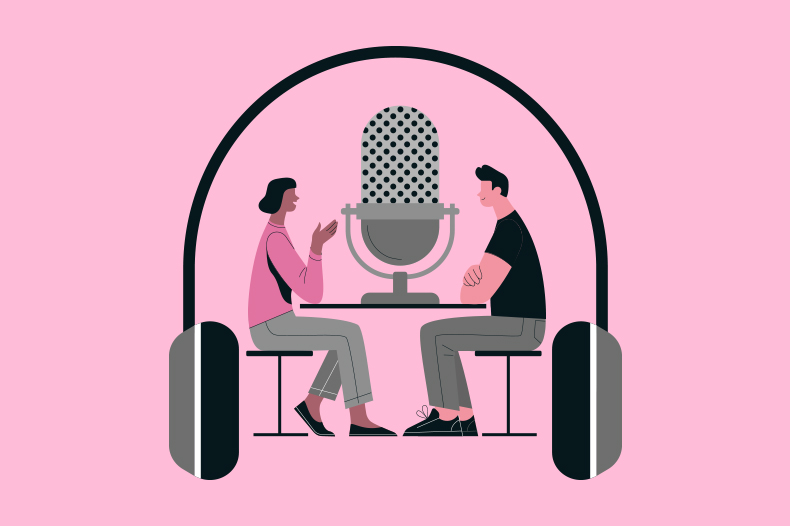Honey, I started a podcast
Why take your IP skills to the airwaves? Aaron Wood talks us through his thinking.

The rise of podcasting is a trend that no one can have missed. Yet only a small band of legal firms have so far created a podcast, and the landscape is littered with efforts that amount to just a few episodes. As someone who has recently launched a podcast of my own, CITMA Review asked me to weigh in on why I’ve done so and what I’ve learned in the process.
Why bother?
“Why bother?” is the ultimate question behind any marketing activity. If we assume that the purpose of any such activity is to have some impact on your firm’s workload, then the key question of “Why?” should determine not just whether you do it, but also how.
To generate work, many firms simply open the doors and wait for instructions from longstanding clients, intermediaries and other departments. In that case, marketing activities can be difficult to justify if they are aimed at winning new clients. They may be valuable, however, if they increase the work coming from existing clients or push them to do new work.
My experience of marketing activities is that they can be intermingled with service delivery to provide some time and cost savings and to improve the client experience. As I will explain later, this is one area where podcasts can work. But without peeking too far into the marketing playbook, my view is that I get work from three places: other attorneys (in the UK and overseas); end clients who are reasonably or very sophisticated; and “standard” clients.
A legal podcast that works for all three is probably impossible: provide content to the first two, and the third will be bamboozled. Provide it to the third, and it will be too basic for the first two. I decided to focus on the first two segments.
As to the “why”, to my mind there are four key elements to winning new work:
- Potential clients need to know that I exist;
- They need to know that I am knowledgeable;
- They need to believe that they could work with me; and
- An opportunity needs to arise for them to work with me.
For most of my work, I am grateful for the badge of honour of being a Chartered Trade Mark Attorney. If the client knows what this means, then they already understand that the second requirement has been met. But otherwise, my marketing work tends to focus on putting out content that makes it clear that I am knowledgeable, particularly in places where I will get traction. This might entail converting existing written content into opportunities to interact with me or hear me, and then converting those opportunities into one-to-one discussion and pitches.
Brochures and newsletters are great in the sense that they demonstrate expertise, but many have very poor open rates as they require focused time to read. Plus, even if the prospective client loves the newsletter, they still haven’t “met” you, heard your voice or imagined what it might be like to work with you.
A podcast solves some of those issues: it can be listened to when the prospective client has time, such as on car journeys or in the gym. Even better, they get to hear your voice, so that by the time they actually speak to you they may have been “conversing” with you for hours via podcasts. Given that part of my work is undertaking advocacy at UK IPO hearings for other firms of trade mark attorneys and taking care of litigation, hearing me talk about cases is a key hurdle overcome.
Fixing my focus
A key step is to decide not just who your target audience is, but also who it is not. I think a huge mistake many firms make in their marketing is to try to address everyone, with the result that they engage no one. I decided to focus on in-depth discussions with those at the “coal face”. Standard trade mark prosecution clients would probably get nothing from it, but some might realise that I am knowledgeable and send me work anyway.
Once you’ve decided on your audience, consider what they might want to hear about, who they might want to hear from and how long they might be willing to listen. My conclusions were that they would want to hear about “core” cases in depth and also issues on the periphery that contacts might expect them to know about. I also felt that they would want to hear from lively and engaging speakers who were willing to go out on a limb a little and not just cover things in a “safe” and boring way. Finally, I concluded that they would probably want to hear a lot more detail than they would get from other sources and that they would be willing to go “long-form”.
The plan was for this to be a weekly podcast. Before I started, I set (and broke) a rule that I would have six to eight episodes in the “bank”, as it seemed like that was the point at which some of the other podcasts tended to run dry. I also made another important decision: I would have competitors on the podcast – a real point of difference from podcasts that were intended solely to promote a firm’s services. I would find the best and most engaging speakers on a subject, whether they were competitors, clients or overseas lawyers.
Getting technical
I have been fortunate enough to chair webinars for CITMA in the past, which means that I am used to – and positively enjoy – getting on the mic and learning new things. Of course, my work as an advocate also helps here, but I find I do have to resist the temptation to cross-examine the guests. One important element of my podcast, I decided, was that it would not be too highly edited. I wanted the listener to really get the feeling of it being a conversation rather than a formal presentation. This has meant that occasionally there are small gaps or filler words, or one speaker speaks over another. Personally, I think that is part of the charm.
The main difficulty for me, then, was understanding the technical requirements. I came into it with absolutely no experience in recording and very little experience in editing, but I had recourse to a few experienced people who gave me some direction.
I have learnt that you can produce a podcast on very little, or you can spend many thousands of pounds. At the very bottom of the budget is simply recording in on your mobile device or a voice recorder and uploading the audio files. This may require no extra spending at all (other than perhaps a new headset and mic to plug into your mobile phone). At the top-end is a soundproofed location with top-of-the-range equipment and software. I decided on an intermediate option, including a range of XLR mics (considered to be audio industry-standard), a RODE-branded board with seven inputs and faders (including a line in and a Bluetooth input) and some free-to-use editing software called Audacity. The Bluetooth and line-in options make it straightforward to do phone-in interviews.
What type of mic you’ll use is a crucial choice. You can get a very high-quality condenser mic with a USB cable for little cost. However, this type of mic tends to pick up all the available sound in the area and requires a pop-filter – a screen placed in front of the mic to avoid the noise of plosive consonants (which produce a sudden release of air). Alternatively, there are also dynamic mics, which often pick up sound in one direction more than others. This makes them ideal for podcasts because they tend to pick up the voice and not any surrounding noise. If you are recording in a house shared with children or a dog, for example, a dynamic mic may be better.
Guest prep
Preparing for the guests is usually fairly straightforward. I try to put together a good intro for them, which I record before they are interviewed so they can hear it and approve it. I have pre-recorded opening and closing credits, so for each episode I simply record the introduction and the interview and stitch them together in Audacity. The interviews themselves tend to be organised in terms of overall subject matter, but I think it’s important to let the interviewee get their character across as well as the content. I want to be a sheepdog cajoling them to stay on point rather than an attack dog!
So, should you start a podcast? My suggestion: if it makes sense for your overall marketing mix and you know your client profile, then a podcast could be a great next step. You can dip your toe in at next to no expense (other than the cost of hosting the podcasts on a listening platform, from as little as £5 a month). As with most things, activity breeds competency: it’s better to get on with it and improve over time than to sit on the sidelines worrying whether you’ll be good enough.
Find Aaron Wood’s IP Show on Apple Podcasts and other platforms.
Aaron Wood is a Trade Mark Attorney at Blaser Mills Law
Read the magazine






